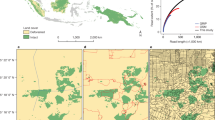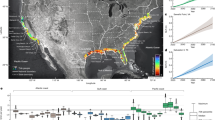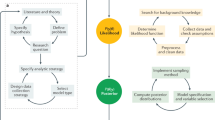Abstract
The science of cities seeks to understand and explain regularities observed in the world’s major urban systems. Modelling the population evolution of cities is at the core of this science and of all urban studies. Quantitatively, the most fundamental problem is to understand the hierarchical organization of city population and the statistical occurrence of megacities. This was first thought to be described by a universal principle known as Zipf’s law1,2; however, the validity of this model has been challenged by recent empirical studies3,4. A theoretical model must also be able to explain the relatively frequent rises and falls of cities and civilizations5, but despite many attempts6,7,8,9,10 these fundamental questions have not yet been satisfactorily answered. Here we introduce a stochastic equation for modelling population growth in cities, constructed from an empirical analysis of recent datasets (for Canada, France, the UK and the USA). This model reveals how rare, but large, interurban migratory shocks dominate city growth. This equation predicts a complex shape for the distribution of city populations and shows that, owing to finite-time effects, Zipf’s law does not hold in general, implying a more complex organization of cities. It also predicts the existence of multiple temporal variations in the city hierarchy, in agreement with observations5. Our result underlines the importance of rare events in the evolution of complex systems11 and, at a more practical level, in urban planning.
This is a preview of subscription content, access via your institution
Access options
Access Nature and 54 other Nature Portfolio journals
Get Nature+, our best-value online-access subscription
$29.99 / 30 days
cancel any time
Subscribe to this journal
Receive 51 print issues and online access
$199.00 per year
only $3.90 per issue
Buy this article
- Purchase on Springer Link
- Instant access to full article PDF
Prices may be subject to local taxes which are calculated during checkout


Similar content being viewed by others
References
Zipf, G. K. Human Behavior and the Principle of Least Effort (Addison-Wesley, 1949).
Auerbach, F. Das Gesetz der Bevölkerungskonzentration. Petermanns Geogr. Mitt. 59, 74–76 (1913).
Arshad, S., Hu, S. & Ashraf, B. N. Zipf’s law and city size distribution: a survey of the literature and future research agenda. Physica A 492, 75–92 (2018).
Gan, L., Li, D. & Song, S. Is the Zipf law spurious in explaining city-size distributions? Econ. Lett. 92, 256–262 (2006).
Batty, M. Rank clocks. Nature 444, 592–596 (2006).
Duranton, G. & Puga, D. in Handbook of Economic Growth Vol. 2 (eds Aghion, P. & Durlauf, S.) 781–853 (Elsevier, 2014).
Córdoba, J.-C. On the distribution of city sizes. J. Urban Econ. 63, 177–197 (2008).
Rossi-Hansberg, E. & Wright, M. Urban structure and growth. Rev. Econ. Stud. 74, 597–624 (2007).
Gibrat, R. Les inégalités économiques (Librairie du Recueil Sierey, 1931).
Gabaix, X. Zipf’s law for cities: an explanation. Q. J. Econ. 114, 739–767 (1999).
Bouchaud, J.-P. Crises and collective socio-economic phenomena: simple models and challenges. J. Stat. Phys. 151, 567–606 (2013).
Bettencourt, L. & West, G. A unified theory of urban living. Nature 467, 912–913 (2010).
Soo, K. T. Zipf’s law for cities: a cross-country investigation. Reg. Sci. Urban Econ. 35, 239–263 (2005).
Singer, H. The “Courbe des populations”. A parallel to Pareto’s law. Econ. J. 46, 254–263 (1936).
Gabaix, X., Lasry, J. M., Lions, P. L. & Moll, B. The dynamics of inequality. Econometrica 84, 2071–2111 (2016).
Pumain, D. & Moriconi-Ebrard, F. City size distributions and metropolisation. GeoJournal 43, 307–314 (1997).
Barthelemy, M. The Structure and Dynamics of Cities (Cambridge Univ. Press, 2016).
Corominas-Murtra, B. & Solé, R. Universality of Zipf’s law. Phys. Rev. E 82, 011102 (2010).
Pumain, D. Une théorie géographique pour la loi de Zipf. Reg. Dév. 36, 125–150 (2012).
Marsili, M. & Zhang, Y.-C. Interacting individuals leading to Zipf’s law. Phys. Rev. Lett. 80, 2741–2744 (1998).
Cottineau, C. MetaZipf. A dynamic meta-analysis of city size distributions. PLoS One 12, e0183919 (2017).
Benguigui, L. & Blumenfeld-Lieberthal, E. A dynamic model for city size distribution beyond Zipf’s law. Physica A 384, 613–627 (2007).
Blank, A. & Solomon, S. Power laws in cities population, financial markets and internet sites (scaling in systems with a variable number of components). Physica A 287, 279–288 (2000).
Krugman, P. Confronting the mystery of urban hierarchy. J. Jpn. Int. Econ. 10, 399–418 (1996).
Ioannides, Y. & Overman, H. Zipf’s law for cities: an empirical examination. Reg. Sci. Urban Econ. 33, 127–137 (2003).
Favaro, J. M. & Pumain, D. Gibrat revisited: an urban growth model incorporating spatial interaction and innovation cycles. Geogr. Anal. 43, 261–286 (2011).
Zanette, D. H. & Manrubia, S. C. Role of intermittency in urban development: a model of large-scale city formation. Phys. Rev. Lett. 79, 523–526 (1997).
Cottineau, C., Reuillon, R., Chapron, P., Rey-Coyrehourcq, S. & Pumain, D. A modular modelling framework for hypotheses testing in the simulation of urbanisation. Systems 3, 348–377 (2015).
Bettencourt, L. & Zünd, D. Demography, symmetry and the emergence of universal patterns in urban systems. Nat. Commun. 11, 19 (2020).
Black, D. & Henderson, V. Urban evolution in the USA. J. Econ. Geogr. 3, 343–372 (2003).
Eeckhout, J. Gibrat’s law for (all) cities. Am. Econ. Rev. 94, 1429–1451 (2004).
Benguigui, L. & Blumenfeld-Lieberthal, E. The end of a paradigm: is Zipf’s law universal? J. Geogr. Syst. 13, 87–100 (2011).
Bouchaud, J. P. & Mézard, M. Wealth condensation in a simple model of economy. Physica A 282, 536–545 (2000).
Erlander, S. & Stewart, N. F. The Gravity Model in Transportation Analysis: Theory and Extensions (VSP, 1990).
Simini, F., Gonzalez, M. C., Maritan A. & Barabasi, A.-L. A universal model for mobility and migration patterns. Nature 484, 96–100 (2012).
Gnedenko, B. V. & Kolmogorov, A. N. Limit Distributions for Sums of Independent Random Variables (Addison-Wesley, 1954).
van Kampen, N. G. Itô versus Stratonovich. J. Stat. Phys. 24, 175–187 (1981).
Srokowski, T. Multiplicative Lévy processes: Itô versus Stratonovich interpretation. Phys. Rev. E 80, 051113 (2009).
Jespersen, S. M. R. & Fogedby, H. C. Lévy flights in external force fields: Langevin and fractional Fokker–Planck equations and their solutions. Phys. Rev. E 59, 2736–2745 (1999).
Schertzer, D., Larchevêque, M., Duan, J., Yanovsky, V. & Lovejoy, S. Fractional Fokker–Planck equation for nonlinear stochastic differential equations driven by non-Gaussian Lévy stable noises. J. Math. Phys. 42, 200–212 (2001).
Fox, C. The G and H functions as symmetrical Fourier kernels. Trans. Am. Math. Soc. 98, 395–429 (1961).
Clauset, A., Shalizi, C. R. & Newman, M. E. Power-law distributions in empirical data. SIAM Rev. 51, 661–703 (2009).
United States Census Bureau. Metro area-to-metro area migration flows: 2013–2017 American Community Survey; https://www.census.gov/data/tables/2017/demo/geographic-mobility/metro-to-metro-migration.html (United States Census Bureau, 2019).
INSEE. Migrations résidentielles en 2008: lieu de résidence actuelle – lieu de résidence antérieure; https://www.insee.fr/fr/statistiques/2022291 (INSEE, 2011).
Park, N. Internal migration: matrices of moves by local authority and region (countries of the UK) 2012–2016; https://www.ons.gov.uk/peoplepopulationandcommunity/populationandmigration/migrationwithintheuk/datasets/matricesofinternalmigrationmovesbetweenlocalauthoritiesandregionsincludingthecountriesofwalesscotlandandnorthernireland (Office for National Statistics, 2019).
Statistics Canada. Interprovincial and intraprovincial migrants, by census metropolitan area of origin and destination for the period from July 1 to June 30; https://doi.org/10.25318/1710008701-eng (Statistics Canada, 2020).
Acknowledgements
V.V. is supported by the Ecole nationale des ponts et chaussées and by the Complex Systems Institute of Paris Île-de-France (ISC-PIF). V.V. thanks J. Morán for discussions and comments.
Author information
Authors and Affiliations
Contributions
V.V. and M.B. designed the study, V.V. acquired the data, and V.V. and M.B. analysed and interpreted the data and wrote the manuscript.
Corresponding author
Ethics declarations
Competing interests
The authors declare no competing interests.
Additional information
Peer review information Nature thanks Amos Maritan and the other, anonymous, reviewer(s) for their contribution to the peer review of this work.
Publisher’s note Springer Nature remains neutral with regard to jurisdictional claims in published maps and institutional affiliations.
Extended data figures and tables
Extended Data Fig. 1 No universal exponent.
We show here the measured Pareto exponent of the upper tail of city-size distributions as a function of the lower threshold defining the tail for the largest cities of eight different countries. The exponents are obtained with a maximum-likelihood estimate (data from https://simplemaps.com/data/world-cities).
Extended Data Fig. 2 In- and out-neighbours.
a, b, Number of in- and out-neighbours (in the sense of graph theory) for the USA (a) and France (b). The red lines correspond to the equality Nin = Nout. In the UK and Canada, we have a fully connected dataset and Nin = Nout = constant. c, d, Number of neighbours for each city as a function of population for the USA (c) and France (d). The dotted red lines indicate the power-law fit |Ni| ∝ \({S}_{i}^{\gamma }\). In the UK and Canada, we have a variance of the normalized quantity fully connected dataset and γ = 0.
Extended Data Fig. 3 Density function of the out-of-system growth rate.
Natural growth and out-of-system migrations include international migrations and exchanges with small towns. The data shown are for US cities in 2013–2017 (top) and French cities (bottom) in 2003–2008, compared to a normal distribution. We note that a power-law fit of the right or the left tail would lead to a Pareto exponent of β ≫ 1. For French cities, we extrapolated the 2003 population in each city from the 1999 and 2006 censuses to test our assumption on the period 2003–2008.
Extended Data Fig. 4 Migration-flow analysis.
Complementary figure to Fig. 2. Empirical left-cumulative distribution function of renormalized migration flows compared to Lévy (continuous red line) and normal (green dashed lines) distributions. Clockwise from top left, distributions are given for France, the USA, Canada and the UK.
Extended Data Fig. 5 Average distribution of city sizes.
Data obtained by 10 numerical runs of the stochastic differential equation (10) with a Gaussian noise with finite variance ση, compared with the numerical solution of equation (10) where η = ⟨η⟩ = r. Parameters here are α = 1.3, β = 0.8, r = 0.01, ση = 0.06, D = 0.06 and t = 500.
Extended Data Fig. 6 Scatterplot of the quantity P(S, t) × S versus the ratio for France’s top-500 largest cities between 1875 and 2016.
Each colour is a different year. We observe that the plots of all years collapse towards a unique universal function of the ratio in agreement with the result of equation (33) in Supplementary Information.
Extended Data Fig. 7 Power-law fit of the expansion with α = 1.3, as a function of the lower threshold of city sizes, Smin.
The expansion is described in equation (25) in Supplementary Information. The fit gives an apparent exponent α(Smin) with very good quality (R2 ≈ 1), although the expansion itself is not a power law. The apparent exponent is smaller than α, but slowly converges towards α = 1.3 as the value of the threshold Smin increases. Parameters here are α = 1.3, β = 0.8, r = 0.01, D = 0.06 and t = 500.
Extended Data Fig. 8 Rank clocks of the USA and the UK.
Top, USA; bottom, UK. The left panels display real data, the middle panels show Gabaix’s model of growth and the right panels give our model of growth. Parallel lines for earlier years are spurious effects resulting from the absence of data for cities out of the top-100 largest in the USA or the top-40 largest in the UK (for these rank clocks, we assigned a random increasing radius to cities without data).
Extended Data Fig. 9 Microdynamics of city rank through time for the largest cities in France, the USA and the UK.
Data is given for the 500 largest cities in France between 1875 and 2016 (top), the 100 largest cities in the United States between 1790 and 1990 (middle) and the 40 largest cities in the UK between 1861 and 1991 (bottom). The left panels display the right-cumulative distribution of the maximal variation of the rank ri(t) for city, that is, the difference between the highest and the lowest rank in population for each city. The right panels display the typical fluctuations of the rank ri(t) through time. In the three cases, the Lévy model is able to predict rare but non-negligible large variations of rank such as the sudden birth or death of city, in contrast to Gabaix’s model or Gibrat’s model for growth, for which large fluctuations of rank order do not occur.
Extended Data Fig. 10 Average number of years (and standard dispersion) taken to observe the maximal rank variation ∆r as a function of ∆r.
Although the dispersion is large, Lévy’s model is compatible with real data, in contrast to Gabaix’s model of growth.
Supplementary information
Supplementary Information
This file contains a Supplementary Discussion.
Rights and permissions
About this article
Cite this article
Verbavatz, V., Barthelemy, M. The growth equation of cities. Nature 587, 397–401 (2020). https://doi.org/10.1038/s41586-020-2900-x
Received:
Accepted:
Published:
Issue Date:
DOI: https://doi.org/10.1038/s41586-020-2900-x
This article is cited by
-
Defining a city — delineating urban areas using cell-phone data
Nature Cities (2024)
-
A maximum entropy approach for the modelling of car-sharing parking dynamics
Scientific Reports (2023)
-
Spatial structure of city population growth
Nature Communications (2022)
-
Dynamics of ranking
Nature Communications (2022)
-
A model for simulating emergent patterns of cities and roads on real-world landscapes
Scientific Reports (2022)
Comments
By submitting a comment you agree to abide by our Terms and Community Guidelines. If you find something abusive or that does not comply with our terms or guidelines please flag it as inappropriate.



